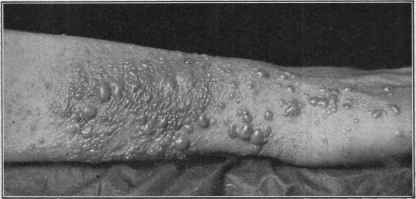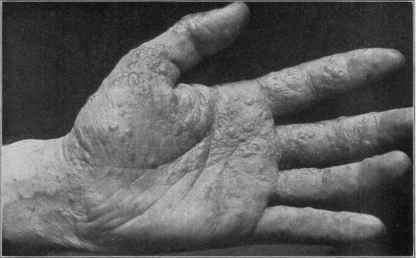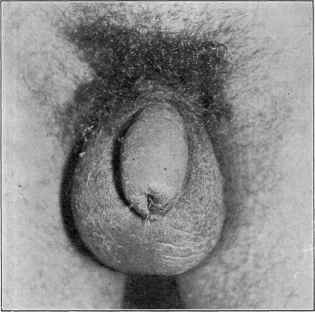| MEDICAL INTRO |
| BOOKS ON OLD MEDICAL TREATMENTS AND REMEDIES |
THE PRACTICAL |
ALCOHOL AND THE HUMAN BODY In fact alcohol was known to be a poison, and considered quite dangerous. Something modern medicine now agrees with. This was known circa 1907. A very impressive scientific book on the subject. |
DISEASES OF THE SKIN is a massive book on skin diseases from 1914. Don't be feint hearted though, it's loaded with photos that I found disturbing. |
DERMATITIS VENENATA
Definition and Causes—Under the head of dermatitis venenata
are included all those inflammatory conditions of the skin due to con
tact with or to the action of caustics, chemical irritants, drugs, plants,
and other deleterious substances. These agents are for the most part
essentially chemical. The substances which may be responsible for
dermatic inflammation are almost innumerable. Many of them are
more or less irritating to all skins, some are harmless or practically so
to a large number, while in others again the action is so exceptional as
to be due to some peculiar idiosyncrasy. Among the most common are
the various irritant drugs, as arnica,, mustard, cantharides, mercurials,
iodoform, iodin, carbolic acid, oil of turpentine, dye-stuffs, petroleum
products, alkalies and acids, and many others; among irritating articles
of wearing apparel and everyday use irritant to some individuals may
be mentioned strong soaps, anilin and corallin dyes, especially in socks
and veils; many of the quack stimulating oils for rheumatism, etc.
Among the trade causes may be mentioned the constant handling of
sugars, flour, polishing material, pastes, tobacco, and similar substances.
Metol, used by photographers, is occasionally responsible for an eczema-
toid dermatitis.
Workers in petroleum products, especially coal-tar and its com
pounds,1 occasionally exhibit various kinds of cutaneous lesions resulting
therefrom—dry erythematous and erythematosquamous skin, come
dones, acne, pigmentation resulting from the chronic irritation, papules,
pustules, furuncles, warty growths, and other keratoses—hence the
terms tar acne, tar dermatitis, pitch dermatitis, etc Warty and kera-
totic growths from these sources not infrequently have shown an epi-
theliomatous tendency.
Plants also furnish a somewhat prolific source of dermatic inflamma
tion. As with almost all other substances, certain plants are more fre
quently causative, while some others may only occasionally bring about
such action, and by far the large majority are wholly devoid of irritating
properties. Idiosyncrasy plays an important part. The various plants
which may provoke such irritation in susceptible subjects are at least
1 Ehrmann, Monatshefte, 1909, vol. xlviii, p. 18, has had an observation of 25 to 30
cases among the workers in these products in Mannheim, and Zweig has also recently
(Dermatolog. Zeitschr., 1909, vol. xvi, p. 85, with some literature references) considered
the subject in its relation to its finally engendering cancer.
DERMATITIS VENENATA 439
sixty or seventy. The most common and best known of this group are
the rhus plants. These furnish, in season, our clinics with a large num
ber of examples of dermatitis venenata of varying grade. The several
plants of the rhus species are somewhat common in different parts of our
country, and some are more poisonous than others. These plants are:
rhus toxicodendron, a climbing plant (poison ivy), and as an independent
shrub or small tree (poison oak); rhus venenata, a shrub or small tree
rarely exceeding the height of fifteen or sixteen feet, also known as poison
dogwood, poison sumac, and poison elder; rhus diversiloba, and rhus
pumila, the former a climbing and the latter a creeping shrub, both of
rather limited distribution; and rhus vernix, from which the varnish for
Chinese lacquer work is made.
The various other plants1 which are sometimes provocative are too
numerous to mention individually, and, moreover, are much less fre-

Fig. 105.—Dermatitis venenata from exposure to poison-ivy, following shortly after
exposure; vesicular and bullous lesions; not an uncommon type; hands and forearms
involved; a few days’ duration.
quently causative. Among the best known are urtica doica (nettle),
primula obconica (primrose), mucuna pruriens (cowhage), polygonum
punctatum (smartweed), podophyllum, balsamum Gileadense (balm
of Gilead), nerium oleander (oleander), and ruta (rue).2 Primrose
dermatitis,3 of variable degree, usually from the hothouse or domesti-
1 For further information on this and other points, the reader is referred to the
monograph on Dermatitis Venenata by Dr. James C. White, Boston, 1887; and to Dr.
P. A. Morrow‘s work on Drug Eruptions, New York, 1887, and “Dermatitis Venenata
—A Supplemental List,” by Dr. James C. White, Jour. Cutan. Dis., 1903, p. 441 (with
references); Evans, Brit. Jour. Derm., 1905, p. 447, refers to several cases occurring in
workers on teak wood.
2 E. Hoffmann, Münch, med. Wochenschr., No. 44, 1904, in addition to referring to
the dermatitis produced by the primrose, states that, among other plants, he has seen
cases due to the chrysanthemum, fresh squillroot, and arbor vitæ.
3 Foerster, “Primula Dermatitis,” Jour. Amer. Med. Assoc., Aug. 20, 1910, with
review of subject and references, thinks it due to secretion and not hairs of the plant—
alcohol dissolves secretion; Zeisler, “Some Uncommon and Often Unrecognized
Forms of Toxic Dermatitis,” Jour. Amer. Med. Assoc, Jan. 29,1912, p. 2024; Sharpe,
“Primula Dermatitis, Its Occurrence in Rural Districts,” Jour. Amer. Med. Assoc.,
Dec 14, 1912, p. 2148 (from wild primrose, primula farinosa).
440
INFLAMMATIONS
cated variety, but also from the wild plant, is quite frequently observed
in England and the United States, a number of such cases having come
under my observation in the past few years.
Symptoms.—The symptoms of dermatitis venenata are varied, de
pending upon the individual susceptibility and upon the character and
duration of contact of the irritating substance. All degrees are met
with, from that of simple irritation to that of gangrenous action. In
termediate degrees of papulation, vesiculation, erysipelatous and edema-
tous swelling, and the formations of bullæ are all encountered; and, in
rare instances, superficial destruction and ulceration.
In almost all cases the dermatitis runs a somewhat acute course and
terminates spontaneously in recovery, and, except in the rare and ex
treme instances of suppurative and destructive action, without trace
or scar. In subjects eczematously inclined the artificial dermatitis

Fig. 106.—Dermatitis venenata from exposure to poison ivy; the hands, forearms, and
face involved, with numerous vesicles and blebs.
may develop into a true eczema, more especially after two or three
attacks, or from persistent action of the irritant. The subjective symp
toms of burning and itching are somewhat variable; they may be ex
tremely troublesome or very slight, and even wanting.
Some of the cases due to the more common causes may be referred
to. That irritation is produced by many drugs is well known. Even
the constant use of the various antiseptics in susceptible individuals
tends eventually to bring about a variable dermatitis, essentially an
eczema, usually slight, but sometimes persistent. This is not infre
quently encountered in surgeons and nurses (surgeons’ eczema; nurses’
eczema), especially after a series of prolonged operations, during which
the hands have been more or less constantly in contact with corrosive
sublimate, carbolic acid, or formaldehyd solutions; the repeated use of
DERMATITIS VENENATA
441
strong soap, such as sapo viridis or the tincture of green soap, used in
washing the hands, is also often a factor. A mild degree of dermatitis
is sometimes encountered in patients from the use of antiseptics and
antiseptic gauzes and other dressings. In many of these instances there
is, of course, a pronounced individual idiosyncrasy.
Iodoform (iodoform dermatitis, iodoform eczema), more especially
when used in powder form, is a not infrequent source of such irritation
(Neisser, Taylor, Watkins, and many others). The use of this drug is
responsible for occasional inflammatory action, which may be quite
positive, and sometimes long continued. The character of the inflam
mation varies from that of erythematous to vesicular and bullous; often

Fig. 107.—Dermatitis venenata from exposure to poison ivy. Marked edematous
swelling of the scrotum and penis; also slight involvement of face and hands; two
days’ duration, developing ten or twelve hours after exposure.
it is of an apparently eczematous character. It usually starts at the
seat of the dressing, and may continue to be so limited; often, however,
it spreads from this point and involves the immediate neighborhood,
and may even extend to other regions. I have met with several cases
of rebellious eczema which had their start in the local use of this drug.
It may, moreover, through absorption, also be provocative of more or
less general cutaneous manifestations of varied character, and if exten
sive or severe, with associated, temporarily at least, systemic disturbance
(see Dermatitis Medicamentosa).
The popular use of arnica tincture has also been the cause of some
cases of violent dermatitis (Cartier, Bauvais, Mouillot, Bowles, Dale,
and others), which may extend much beyond the part to which it is
442
INFLAMMA TIONS
applied, and present as an erythematous, erysipelatous, vesicular,
bullous, and even gangrenous inflammation; and in some cases there
may be severe constitutional symptoms accompanying. Occasionally
other drugs1 will provoke, in certain subjects, a variable degree of der
matic inflammation, among which may be mentioned tincture of iodin,
chrysarobin, blue ointment and other mercurial ointments, tar prepara
tions, and pyrogallol. The symptoms vary with these, usually being of
mild character—erythematous, erythematosquamous, and vesicular;
pyrogallol may exceptionally lead to superficial destruction. Hair-
dyes occasionally furnish interesting cases of an acute and subacute
type, often extending on to forehead, face, neck, and ears; especially a
rather common proprietary one of recent years, the dermatitis being
apparently due to paraphenylene diamin.2
The dermatitis observed is those working in trades is usually, when
coming under observation, of distinctly eczematous nature; for instance,
the so-called bakers’ itch, grocers’ itch, the irritation seen in book-
pasters, polishers, etc.; the dermatitis produced by some of these factors
may occasionally be acute in type, but, as a rule, it is gradual, and in the
latter resulting in a veritable eczema. This subject (occupation der-
matoses) is more fully referred to under Eczema.
The cases of dermatitis venenata most frequently met with are,
however, those in which the action has been due to exposure to the rhus
plants (rhus poisoning, ivy poisoning). Some persons are entirely
immune; some, but slightly susceptible; others, quite vulnerable, while
not a few can scarcely go near the plants without an attack. In some
instances a gradual immunity seems to be established, more especially
as the patient grows older, but this is rather exceptional than the rule.
The irritation may be almost immediate, but it generally follows some
hours or a day or so after exposure. The hands, forearms, sometimes
face, and not infrequently the genitalia and anal region, are favorite
localities. It presents either an erythematous rash, with more or less
swelling, or may have a pronounced erysipelatous aspect; sometimes
the affected regions are studded over with vesicles, or in some cases
with both vesicles and bullæ. In others again the blebs may be con
fluent and the integument in places more or less denuded, and presenting
a weeping red surface; occasionally there is also pus-formation. The
first parts usually attacked are, for obvious reasons, the hands or face,
to which it may remain limited, or other regions may later become in
volved, either as the effect of the same exposure or as a result of the irri
tant being conveyed by the hands. It would seem possible, too, that
the irritant might be conveyed by a person himself immune to one sus
ceptible. If the disease is caused by the oily constituent of the plant
known as toxicodendrol, there is explanation why, in the early part of
the attack, it may be auto-inoculable, and also be even conveyed from one
person to another; this latter accident is, however, extremely rare. In
1 Orthoform, as well as many other drugs, commonly thought to be innocuous, will
occasionally provoke irritation and even severe dermatitis: Dubreuilh, “Des Eruptions
orthoformiques,” La presse médicate, No. 40, May 18, 1901 (with bibliography).
2 Mewborn, Jour. Amer. Med. Assoc, May 18, 1901; Editorial, ibid., Sept. 4, 1909;
Chipman, California State Jour, of Med., Aug., 1911; Zeisler, loc. cit.
DERMATITIS VENENATA
443
extensive and markedly inflammatory cases there may at first be some
constitutional disturbance.
The dermatitis produced by these plants usually subsides in mild
forms in the course of several days to a week; in the more pronounced
cases it may last for several weeks to a few months, and, as already
stated, it may gradually run into a persistent eczema. A spontaneous
recurrence of the irritation for several successive seasons has been alleged,
but this is doubtless due to the fact of reëxposure, although often such
patients may not be aware of it.
Diagnosis.—It may occasionally be difficult to reach, at first, a
positive diagnosis as between some cases of dermatitis venenata and
eczema. A history of the onset, occupation, and exposure will be of aid.
Rhus poisoning frequently begins between the fingers, is usually markedly
acute in character, with a good deal of swelling, with often large vesicles
and blebs, these latter being rarely seen in eczema; in fact, the acuteness,
rather violent characters, and the distribution of the eruption, together
with a history of possible exposure, make up a picture ordinarily con
clusive.
Prognosis and Treatment.—The prognosis has already been in
part referred to. The various types of dermatitis usually subside
spontaneously after the removal of the cause, requiring more or less time
according to the degree of inflarnrnatory action present.
Treatment is essentially that of other inflammatory diseases of like
clinical character, notably that of eczema of the acute type. Rhus
poisoning has had innumerable remedies brought forward, but those
advancing them fail to keep in view the natural tendency of the disease
to spontaneous, and, in many instances, usually rapid, disappearance.
In fact, many slight cases will get rapidly well of themselves, many
others with simple applications; others are more rebellious and yield
slowly. The essential treatment consists in the employment of mild
soothing and slightly astringent applications. As a rule, one of the best
plans is, as in acute eczema, the conjoint use of black wash with an equal
part of lime-water, followed by the plain zinc oxid ointment; or a boric
acid lotion, 2 to 3 per cent, strength, followed by the zinc ointment. The
calamin-zinc-oxid lotion, frequently applied, is also an admirable appli
cation; or, better still, linen cloths kept constantly wet with it, may be
continuously applied. Weak alkaline lotions of borax, sodium carbonate,
or ammonium muriate, of the strength of 1 (0.065) to 2 (0.13) or 3 (0.2)
grains to the ounce (32.), are useful, especially in the milder erythema-
tous types. Weak solutions of sodium hyposulphite, 1 to 10 grains
(0.065-0.65) to the ounce (32.), are also of value. A lotion of the fluid
extract of grindelia robusta, 1 to 2 drams (4.-8.) to about 4 ounces (128.)
of water, and continuously applied (Duhring); a lotion of zinc sulphate,
½ to 2 grains (0.033-0.13) to the ounce (32.), with 2 to 5 grains (0.13-0.33)
of carbolic acid, will likewise often prove useful. The larger vesicles
and the blebs should be punctured and the contents pressed out. Once
every one or two days the parts should be gently bathed with warm
water, tapped dry, and the treatment immediately resumed; occasionally
the washing can be done with a weak alkaline lotion. The various mild
444
INFLAMMA TIONS
ointments may also be employed, either alone, or preferably conjointly
with a lotion as already suggested. An ointment of calamin, 1 dram
(4.), to the ounce (32.) of zinc ointment is often effective.
But first, if you want to come back to this web site again, just add it to your bookmarks or favorites now! Then you'll find it easy!
Also, please consider sharing our helpful website with your online friends.
BELOW ARE OUR OTHER HEALTH WEB SITES: |
Copyright © 2000-present Donald Urquhart. All Rights Reserved. All universal rights reserved. Designated trademarks and brands are the property of their respective owners. Use of this Web site constitutes acceptance of our legal disclaimer. | Contact Us | Privacy Policy | About Us |